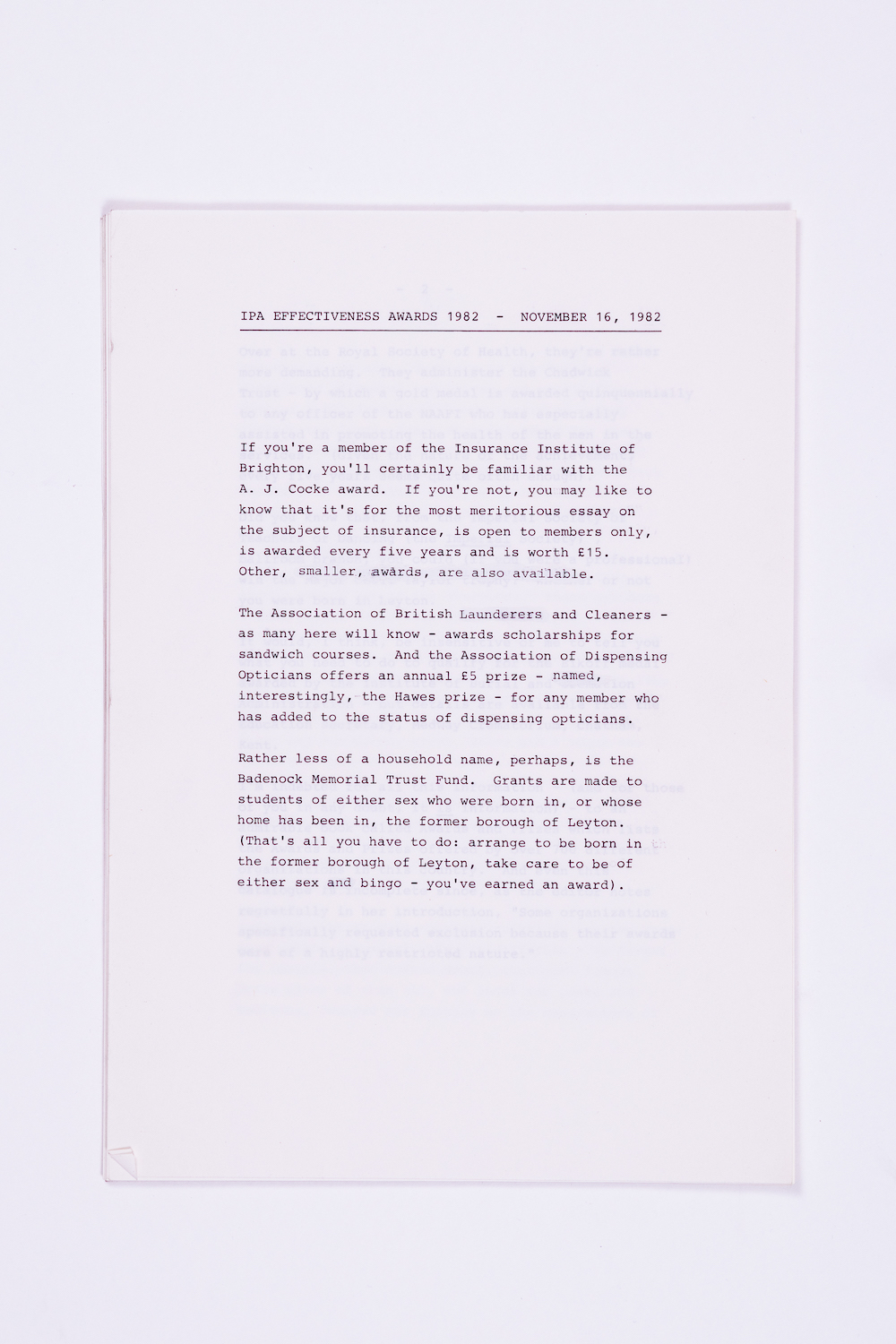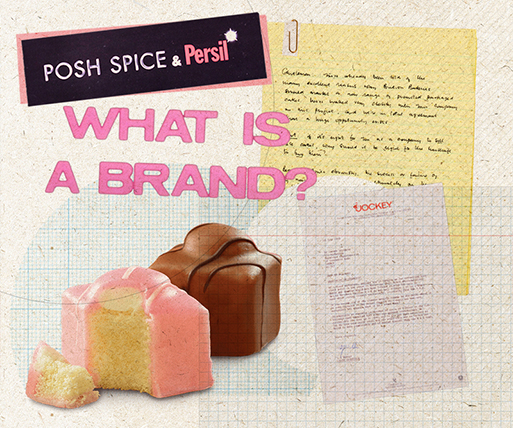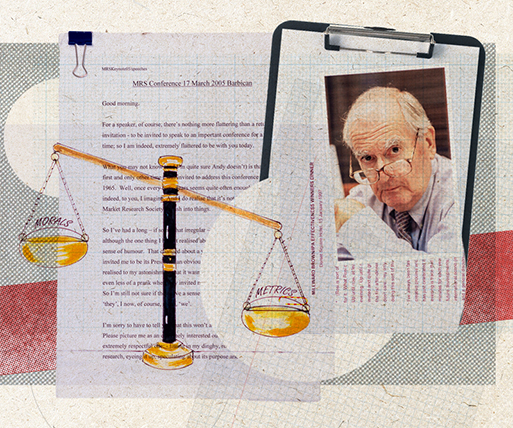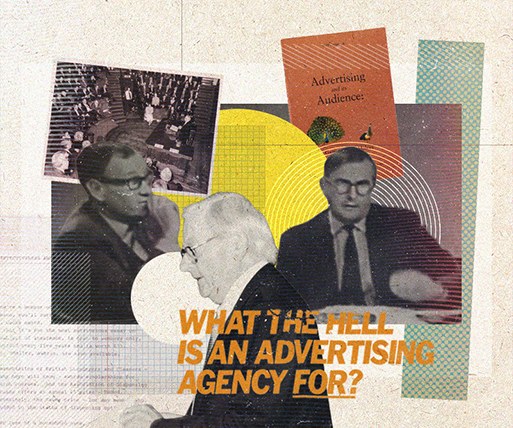IPA Effectiveness Awards speech, 1982
- Date: 1982
- Publisher: Institute of Practitioners in Advertising
- COMMUNICATIONS
Lashings of acerbic wit suffuse this memorable speech about awards and their motives: "One unintentional effect of creative awards can be to encourage irrelevance, facetiousness and, even ironically, limitation”.
IPA Effectiveness Awards speech 1982
If you’re a member of the Insurance Institute of Brighton, you’ll certainly be familiar with the A. J. Cocke award. If you’re not, you may like to know that it’s not for the most meritorious essay about insurance, is open to members only, is awarded every five years and is worth £15. Other, smaller, awards are also available.
The Association of British Launderers and Cleaners – as many here know – awards scholarships for sandwich courses. And the Association of Dispensing Opticians offers an annual £5 prize – named, interestingly, the Hawes prize – for any member who has added to the status of dispensing opticians.
Rather less of a household name, perhaps, is the Badenock Memorial Trust Fund. Grants are made to students of either sex who were born in, or whose home has been in, the former borough of Leyton. (That’s all you have to do: arrange to be born in Leyton, take care to be of either sex and bingo – you’ve earned an award).
Over at the Royal Society of Health, they’re rather more demanding. They administer the Chadwick Trust – by which a gold medal is awarded quinquennially to any officer of the NAAFI who has especially assisted in promoting the health of the men in the services. (Given the nature of the achievement, every five years seems quite often enough).
Did you know that, from the Imperial Society of Teachers of Dancing (the Imperial society), ballroom branch, you could (if you were a professional) win the Major Cecil Taylor trophy? Whether or not you were born in Leyton.
It would, I think, be insensitive of me to tell you what you need to do to qualify for the Eikoff medal awarded by the Institute of Burial and Cremation Administration – but details are available from the Education secretary, Medway Crematorium, Chatham, Kent.
I’m indebted for all this information – (and for those of you in any doubt, it is information) – to an admirable book called “Awards and Prizes” which lists the Awards and Prizes offered by over 700 different organisations in this country. And even this catalogue is incomplete since, as the editor notes regretfully in her introduction, “Some organisations specifically requested exclusion because their awards were of a highly restricted nature.”
And that’s not all. Turn now to the “World Dictionary of Awards and Prizes” and you’ll find another 2,000 from 62 different countries. They include the Portia Geach Memorial Award for the best portrait from life of a person distinguished in Art, Letters and the Sciences by a female artist resident in Australia. Recipients include the 1973 winner, Sylvia Tiarks, for her self-portrait.
It is perfectly clear that – if we all did our research carefully enough – there are more than enough awards around for everybody. There are more awards in the world than there are people. Yet not all of us here tonight have got one. Which must in turn mean that some people got their snorts in the trough. (I wouldn’t for a moment like you to think that I include BMP in that category).
About any award, any prize, there are I think two questions that have to be asked:
Why was it funded in the first place?
What was the motive of the donor?
And second: what effect, what influence has it had?
Sometimes the answers to these questions are the same; more often, I suspect, they’re different – we forget, for example, that Alfred Nobel, the most famous prize giver of them all, not least for peace and medicine, founded his fortune on the manufacture of nitro-glycerine during which, in 1864, he accidentally blew up his youngest brother? (Yes, I think on reflection we should forget that).
But motive and effect do need to be examined separately. There’s a law – which I believe is called Howard’s law – to the effect that every action, and particularly every piece of legislation, create an effect diametrically opposite to that which was intended.
You’ll remember when the Labour Party decided to require all companies to publish the size of their contribution to political parties; an excellent idea, in my opinion, but the motive was to leave the Conservative Party in no position to fight a single by-election. What happened was that every company chairman opened up his competitors’ annual report and shouted “Good God, Sims, Nigel’s given’ ‘em more than we are!” A very good year for the Party Treasurer and all thanks to Howard’s Law.
The more senior amongst us may remember the early days of the Screen Advertising World Association and the Cannes Commercial Film Festival.
The motive was simple, open and unashamed: to promote the use of cinema as an advertising medium and so repulse the fledgling threat of television.
Within a few years, the festival was doing more to promote television as an advertising medium than was altogether good for the blood pressure of the founders. Howard’s Law had struck again.
What are the motives behind creative awards?
A bit mixed, I suspect: easy to mock but mainly admirable. To encourage imagination, innovation, originality and sheer self-critical craftsmanship.
And the effect? Again, I’d say, far more beneficial than not. There’s growing and welcome evidence from both sides of the Atlantic that admirable advertisements, technically beautiful advertisements, involving advertisements, can and do make a direct commercial contribution to the brand or service advertised. And conversely that advertisements that insult the consumers’ intelligence can drain that value away.
It's inevitable, I suspect, that one unintentional effect of creative awards can be to encourage irrelevance, facetiousness and even, ironically, limitation: but if advertisers and their agencies can’t spot these dangers, and eliminate them, then they shouldn’t be allowed to evaluate advertising in the first place.
And so to the IPA Effectiveness Awards. What was the motive for their introduction a couple of years ago?
That’s an easy one. Our present President simply looked at the Krona sales figures and invented a competition he knew he couldn’t lose.
The support he received was of a more respectable nature. There was undoubtedly, I believe, a real need for a new form of award which reminded us all of what advertising was for. It may be slightly shameful that such a need existed – but it did. It was particularly important, I think, that the sponsor of those awards should have been agencies, not advertisers. It would have been all too easy for the creative awards to be the proud property of the irresponsible agencies, and the effectiveness awards the property of those crude and commercial traders who are only in business for the money. Such a distinction would have made it infinitely harder to preserve the unity of interest that, in a sensible world, we all try to preserve.
I’ve long been of the view that, with a few easily detectable exceptions, the only socially irresponsible advertising is wasteful advertising; ill-directed advertising; advertising in lieu of product performance; self-indulgent advertising; an attempt to publish small works of art of somebody else’s expense.
It’s almost certainly too early to assess the effect of these awards – but the signals they send out must be healthy ones. Nor do this year’s winners provide much support for the elderly belief – so often no more than a shuffling excuse for the inadequate – that effectiveness and originality are incompatible or that you have to be boring to sell.
There’s one further effect I believe these awards will have – indeed, already are having. Whether it was foreseen or not, I don’t know. But I believe they will encourage us all, advertisers and agencies, to spend time, more imagination, and a greater application of the emerging technologies, or attempting to isolate the contribution of advertising to an advertiser’s business.
Whatever we may say in public or private, how advertising works, and why it doesn’t when it doesn’t, remains something of a black box business.
The sheer intellectual and technical skills that will increasingly be required when compiling submissions for these awards seem certain over time to increase our knowledge and decrease the chances of irresponsible waste. And the fact that the winning submissions are published; can be read and learned from and the techniques improved upon, seems to me to be very good and very grown-up indeed.
There’s a final theory about the motives for awards I’d like – as they say – to share with you.
Two years ago, these awards were dished out in half-an-hour with a glass of blood-temperature white wine. Tonight, we’re all dressed up at the Savoy. In 1984, we can confidently expect the BAFTA theatre, weeks of speculation in the national press, live television coverage and Melvyn Bragg.
The fact that hundreds of thousands of awards, presented in circumstances of escalating grandeur and expense – from the Insurance Institute of Brighton, the Association of British Launderers and Cleaners, the Badenock Memorial Trust Fund, the Nobel prize, the Chadwick Trust, the Imperial Society of Teachers of Dancing to the Institute of Burial and Cremation Administration – can lead to only one convincing theory: – a conspiracy theory.
The size and growth of the awards industry – and an industry it is – must be the outcome of a brilliantly orchestrated marketing exercise by the Conference and Catering industry. It cannot be a coincidence that in none of the many reference books I’ve studied is there a single mention of an award for the individual or organisation inventing or staging the greatest number of new award ceremonies. But there certainly should be.
My thanks to you, Mr President, for having invited me to be with this evening. My only slightly reserved congratulations to the winners. And my condolences to our competitors who were so curiously slow to identify the creative opportunity presented by printed milk bottles.




